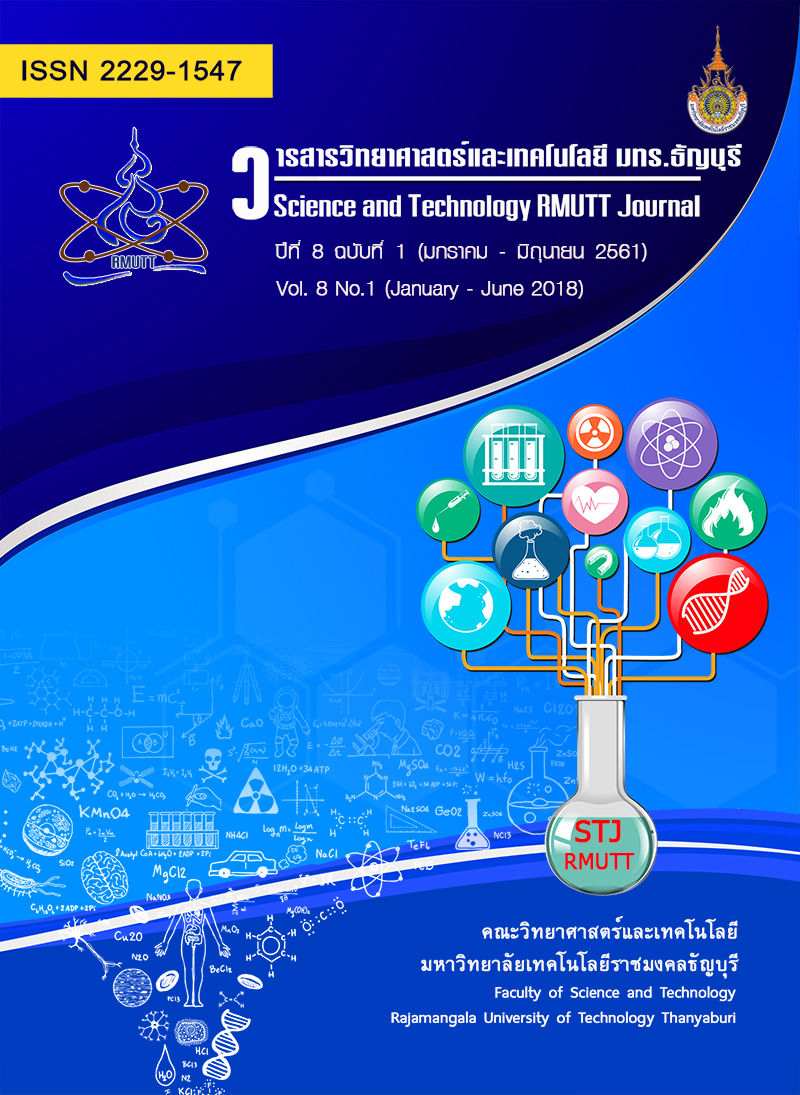Preparation and characterization of methyl 2-aminobenzoate gel
Main Article Content
Abstract
This study investigates the properties of methyl 2-aminobenzoate in gel form by finding the suitable amount and composition of gel preparation. The variables studied were the ratio of distilled water to glycerin at 35: 45.5, 30: 50.5, 25: 55.5, 20: 60.5 and 15: 65.5 respectively. The ratio of carboxymethyl cellulose to hydroxyethyl cellulose at 4:0, 3: 1, 2: 2, 1: 3 and 0:4 respectively. The ratio of methyl 2-aminobenzoate to ethyl alcohol solution at 5:5, 6:4, 7:3, 8:2, 9:1 and 10:0 respectively. The physical property of the gel form is determined by calculating the percentage of syneresis, the percentage of weight loss, the percentage of dimensional stability and the stability. The study found that the amount and composition suitable for gel preparation were the amount of distilled water to glycerin at 25: 55.5 ratio. The amount of carboxymethyl cellulose to hydroxyethyl cellulose at 3:1 ratio, and the ratio of methyl 2-aminobenzoate per alcohol at
Article Details
References
Anne S. Ten question concerning air fresheners and indoor built. Building and Environment. 2017. 111: 279-284.
Poonam A., Schubert P. and David D. The use of thermal analysis to study the change in air-freshner gels. Thermochimica Acta. 1998. 324: 9-13.
Alessandro S., Christian D. and Marta M. Biodegradable cellulose-base hydrogel: Design and application. Materials. 2009. 2: 353-373
Leonard R.A. Efficacy of methyl anthranilate as a bird repellent on cherries, blueberries and grapes. Proceedings of the fifteen vertebrate pest conference. Lincoln, USA. March 1992; 136-141
Gwen R.S. and Larry C. Bird repellent: development of avian-specific tear gases for resolution of human-wildlife conflicts. International Biodeterioration & Biodegradation. 1998. 42: 153-160
Russell M. and Larry C. Grazing repellency of methyl anthranilate to snow geese is enhanced by a visual cue. Crop Protection 1996. 15(1): 97-100.
Richard M.E., Je R.P. and Bernice C. Methyl anthranilate aerosol for dispersing birds from the light lines at homestead air reserve station. International Biodeterioration & Biodegradation. 2002. 49: 175-178.
John L.C. Evaluation of a methyl anthranilate formulation for reducing bird damage to blueberries. Crop Protection 1995. 14(3): 257-259.
Selestina G. and Vanja K. Synthesis and application of new temperature-responsive hydrogels based on carboxymethyl and hydroxyethyl cellulose derivatives for the functional finishing of cotton knitwear. Carbohydrate Polymers. 2011. 85: 664-673.
Lin C.F. and Tarrytown N.J. “Air freshener gel” UK 4,056,612. 1997.
Modi j.j. “Air treatment gel composition” US 5,741,482. 1998.
David J.R Chemistry and Technology of Flavors and Fragrances. Blackwell Publishing Ltd, Oxford, UK. 2005
เกวลิน รัตนจรัสกุล. การพัฒนาฟิล์มต้านจุลินทรีย์จากคาร์บอกซีเมทิลเซลลูโลสร่วมกับน้ำมันสะระแหน่ Mentha piperita. วิทยานิพนธ์วิทยาศาสตรมหาบัณฑิต สาขาการศึกษาวิทยาศาสตร์ บัณฑิตวิทยาลัย. จุฬาลงกรณ์มหาวิทยาลัย. 2555.
จิตตรา ดอกบัว. การศึกษาประสิทธิภาพเซลลูโลสฟอสเฟตจากฟางข้าวและชานอ้อยเพื่อใช้ดูดซับตะกั่วและแคดเมียมในน้ำเสีย.วิทยานิพนธ์วิทยาศาสตรมหาบัณฑิต สาขาวิชาวิทยาศาสตร์ศึกษา บัณฑิตวิทยาลัย. มหาวิทยาลัยราชภัฏวไลยอลงกรณ์ในพระบรมราชูปถัมภ์. 2552.
Astrini N., Anah L. and Haryono A. Crosslinking Parameter on the preparation of cellulose based hydrogel with divynilsulfone. Procedia Chemistry. 2012. 4: 275-281.
Yoldas S., Aylin A., • Basak D. and Caner T. Carboxymethylcellulose (CMC) – hydroxyethylcellulose (HEC) based hydrogels: synthesis and characterization. Original Paper. 2014. 21:1689–1698.
Pengfei L., Maolin Z., Jiuqiang L., Jing P. and Jilan W. Radiation preparation and swelling behavior of sodium carboxymethyl cellulose hydrogels. Radiation Physics and Chemistry. 2002. 63: 525-528.


